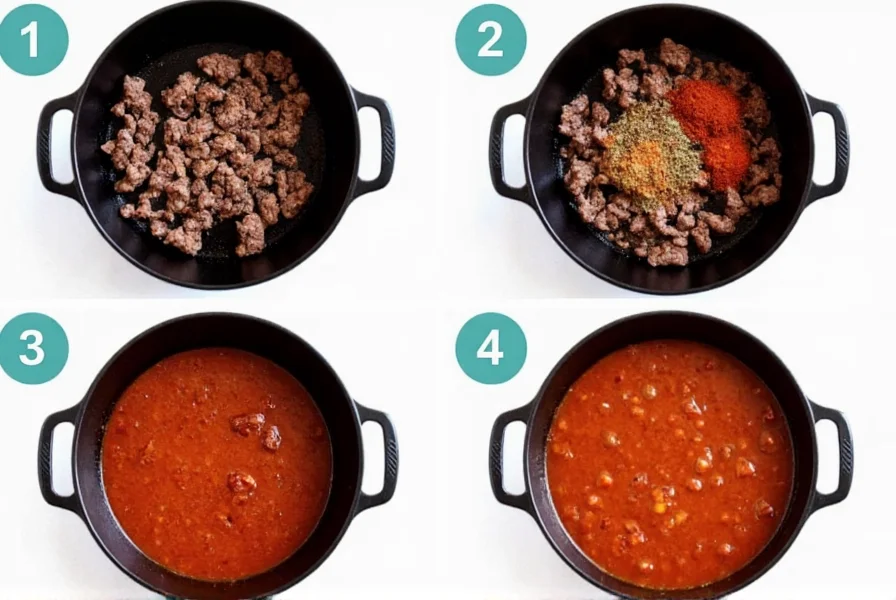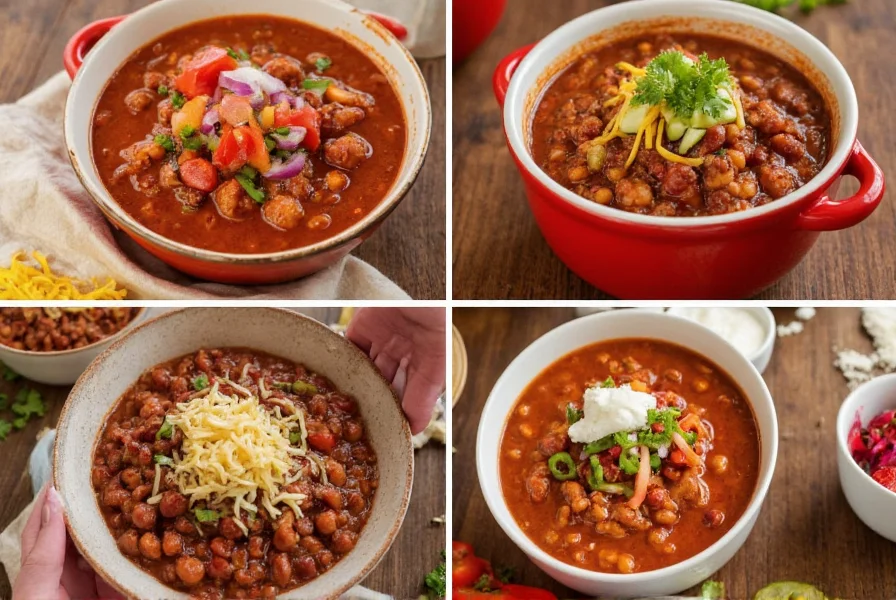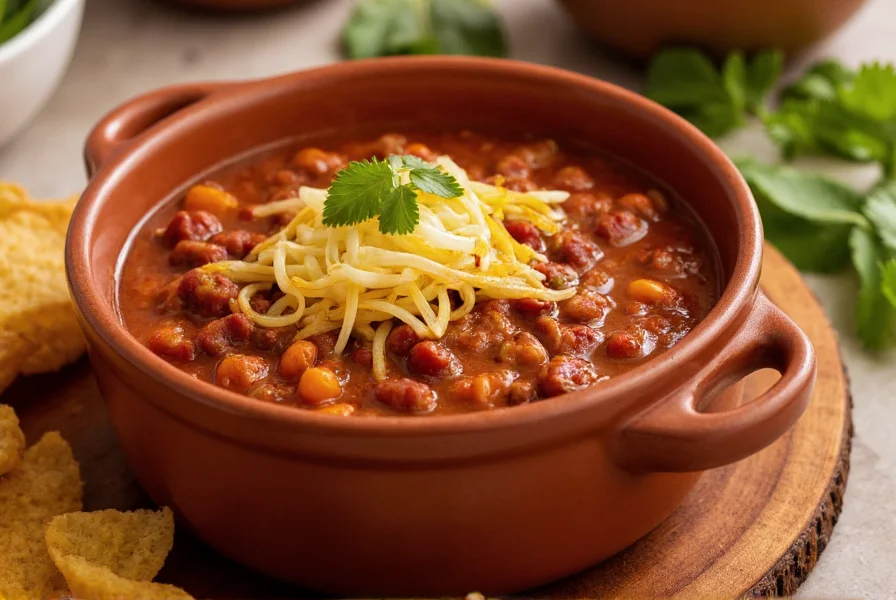Creating exceptional chili isn't just about following a recipe—it's understanding the principles that transform simple ingredients into a complex, satisfying dish. While regional variations exist from Texas red to Cincinnati-style, the foundation remains consistent: quality ingredients treated with care and attention to flavor development.
The Essential Classic Beef Chili Recipe
This foundational recipe serves as your starting point for authentic chili con carne that balances heat, richness, and depth of flavor. What sets this apart from ordinary chili recipes is the attention to ingredient quality and cooking technique.
| Prep Time | Cook Time | Total Time | Servings |
|---|---|---|---|
| 20 minutes | 1 hour 30 minutes | 1 hour 50 minutes | 6 servings |
Ingredients for Authentic Chili
- 2 lbs ground chuck (80% lean for optimal flavor)
- 1 large yellow onion, finely diced
- 4 cloves garlic, minced
- 1 (28-ounce) can crushed tomatoes
- 1 (15-ounce) can kidney beans, drained and rinsed
- 2 tablespoons chili powder (preferably Ancho)
- 1 tablespoon ground cumin
- 1 teaspoon smoked paprika
- 1 teaspoon dried oregano
- 1 bay leaf
- 1 cup beef broth
- 2 tablespoons tomato paste
- Salt and freshly ground black pepper to taste
- 1 tablespoon olive oil
Step-by-Step Preparation
- Brown the meat properly: Heat olive oil in a heavy-bottomed pot over medium-high heat. Add ground chuck in a single layer, letting it develop a proper sear before stirring. This Maillard reaction creates complex flavor compounds essential for great chili.
- Sauté aromatics: Add onions and cook until translucent (about 5 minutes), then add garlic and cook for 1 minute until fragrant.
- Build flavor base: Stir in tomato paste and cook for 2 minutes to deepen its flavor. Add chili powder, cumin, smoked paprika, and oregano, cooking for 30 seconds to toast the spices.
- Combine ingredients: Add crushed tomatoes, beef broth, kidney beans, and bay leaf. Bring to a gentle simmer.
- Slow simmer: Reduce heat to low, cover partially, and simmer for 1-1.5 hours, stirring occasionally. The longer it simmers (up to 3 hours), the more flavors will meld.
- Final seasoning: Remove bay leaf. Season with salt and pepper. For thicker chili, simmer uncovered for the last 15-20 minutes.

Mastering Chili Technique: What Most Recipes Miss
Many easy chili recipes skip crucial techniques that separate good chili from exceptional chili. Understanding these principles allows you to adapt and improve any chili recipe:
The Science of Spice Balance
Chili powder alone won't create depth. The magic happens when you combine:
- Heat elements: Cayenne pepper or fresh jalapeños (add gradually)
- Earthy notes: Cumin and Mexican oregano
- Smoky dimension: Smoked paprika or a touch of chipotle powder
- Sweet counterpoint: A small amount of cocoa powder or dark chocolate
Toast dried spices in the pot before adding liquids to release their essential oils—this simple step dramatically improves flavor integration in your homemade chili recipe.
Popular Regional Variations
Understanding regional styles helps you customize your perfect bowl:
| Style | Key Characteristics | Best For |
|---|---|---|
| Texas Red | No beans, pure meat (often brisket), rich chili powder blend | Meat purists seeking intense flavor |
| Cincinnati Chili | Sweet-spiced, served over spaghetti with cheese | Those who enjoy Mediterranean influences |
| Colorado Style | Bright red from New Mexico chilies, no tomato products | Clean chili flavor enthusiasts |
| Vegetarian Chili | Beans, lentils, mushrooms, roasted vegetables | Plant-based diets without sacrificing depth |

Troubleshooting Common Chili Problems
Even experienced cooks encounter issues with their chili recipe. Here's how to fix them:
Too Spicy?
Add dairy (sour cream or shredded cheese), a touch of sugar, or acidic elements like lime juice. Potato chunks simmered in the chili can also absorb excess heat.
Too Thin?
Create a slurry with 1 tablespoon cornstarch and 2 tablespoons cold water, then stir into simmering chili. Alternatively, mash some beans against the pot side to thicken naturally.
Lacking Depth?
Add umami boosters: a teaspoon of fish sauce, soy sauce, or Worcestershire sauce. A square of dark chocolate (70% cacao) added near the end balances acidity and enhances richness.
Serving and Storage Tips
The perfect chili deserves proper presentation:
- Serving temperature: Serve hot but not scalding—ideal chili temperature is 165-175°F (74-80°C)
- Traditional toppings: Shredded cheddar, sour cream, diced onions, cilantro, and oyster crackers
- Storage: Chili flavors improve overnight. Store in airtight containers for up to 4 days in the refrigerator or freeze for up to 3 months
- Reheating: Gently warm on stove with a splash of broth to restore moisture; avoid boiling
Advanced Customizations for Your Best Chili Recipe
Once you've mastered the basics, experiment with these professional touches:
Meat Variations
While ground beef works well, consider these upgrades:
- Chuck roast: Cut into 1/2-inch cubes for Texas-style chili
- Short ribs: Browned and simmered until fork-tender
- Smoked meats: Add diced smoked brisket or andouille sausage
Bean Options
Experiment beyond kidney beans:
- Pinto beans: Creamier texture, traditional in many regions
- Black beans: Earthy flavor that complements chipotle spices
- Great Northern beans: Mild flavor that absorbs surrounding spices
Why This Recipe Works: The Flavor Science
Great chili isn't accidental—it follows culinary principles that create balanced, complex flavors. The extended simmering time allows:
- Proteins to break down into savory amino acids
- Spice compounds to fully integrate with the base
- Acids from tomatoes to mellow while retaining brightness
- Starches from beans to naturally thicken the mixture
Understanding these processes transforms your approach from merely following instructions to becoming a thoughtful chili maker who can adapt and improve any recipe chili you encounter.











 浙公网安备
33010002000092号
浙公网安备
33010002000092号 浙B2-20120091-4
浙B2-20120091-4